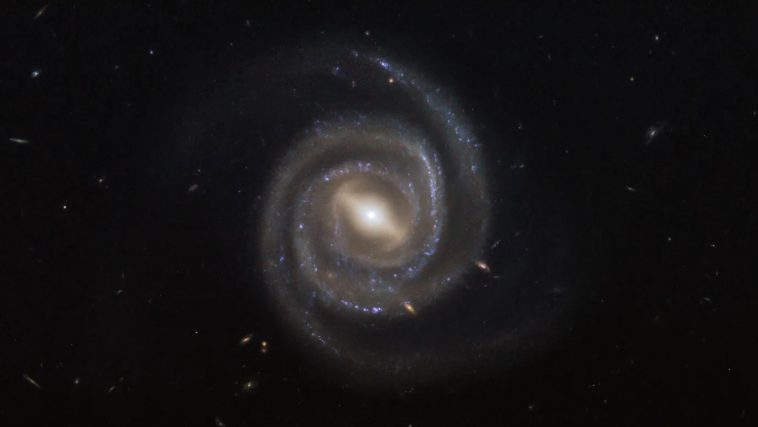[Originally published as Mature Galaxies Continue to Challenge Secular Models]
The James Webb Space Telescope (JWST) has again revealed evidence that challenges the secular origins story and confirms biblical creation.
A team of researchers has discovered evidence of a barred spiral galaxy in the distant universe. This is further evidence that mature galaxies exist at a distance where the secular view predicted only “infant” galaxies should exist.
Barred and Unbarred Galaxies
Spiral galaxies come in a number of variations, such as grand design, multi-armed, and flocculant. Many of them have a long, relatively straight section of their spiral arms near the core — a bar. Barred spirals are quite common in the nearby universe. Roughly 55% of spiral galaxies are barred.1 The galaxy in which we live, the Milky Way, is thought to be barred.
In the Big Bang view of origins, spiral galaxies are supposed to take hundreds of millions of years to form as they gain stars. According to computer simulations, the bar in a spiral is supposed to take about 8 billion years to form; thus, only galaxies with a redshift below 0.5 should have observable bars.2 Galaxies beyond this distance should be unbarred.
Starlight and Time
In the standard secular view, when we peer into the distant universe, we are seeing it as it was billions of years ago rather than as it is now. This is because the distances to the galaxies are so fantastic that their light must take billions of years to reach us. As we have pointed out in previous articles, this is predicated on a particular synchrony convention — a specific way of defining what constitutes “now” in the distant universe. Depending on the method we use to synchronize any hypothetical clocks, the time it takes for light to reach us from a given distant galaxy can be anywhere from billions of years to no time at all. It depends on which synchrony convention we choose. Einstein pointed out that either convention is acceptable. They are equally “true,” as strange as that may seem.
The Bible seems to use a visual synchrony convention (also called the anisotropic synchrony convention or ASC), in which we are seeing the universe in real time no matter how distant the galaxy. Under ASC, the light from all galaxies reaches us immediately due to the way we define “now.” This explains why we can see distant galaxies in a universe that is about 6,000 years old by the ASC system. But it also means that these distant galaxies have not yet received light from our galaxy. Thus, if God indeed described the creation week using ASC, then this implies that our solar system is uniquely positioned in the universe.
Secularists reject the notion that our solar system is unique. Therefore, they prefer to use the Einstein synchrony convention (ESC) when describing origins because it treats all positions equally. They believe that the universe popped into existence about 13.8 billion years ago, that stars formed from the primordial gas, and that these stars assembled into galaxies over hundreds of millions of years. Thus, secularists believe that the earliest galaxies would have been very low mass and clumpy since they supposedly take billions of years to grow into the well-structured spirals we see today. And since secularists use the ESC system, it should be possible to test that claim by looking at the most distant galaxies since this corresponds to very early times in the universe.
Some creationists, such as myself, using the ASC system, would say that we are seeing these distant galaxies as they are now. And since God created the universe in a mature and functioning state, we expected that the most distant galaxies would be mature as well — massive and well structured. Furthermore, since many nearby spiral galaxies have a central bar, we would expect to find bars in some of the most distant galaxies as well.
Expectations and Reality
So, in the secular view, the most distant galaxies are extremely young and, therefore, should be low mass, clumpy, and unbarred. Whereas, in the creation view, the most distant galaxies should be mature (as with all of God’s creation) and thus have mass ranges comparable to nearby galaxies. Furthermore, they should be well structured, and many should be barred. In July 2022, the JWST confirmed that the most distant galaxies are indeed massive and well structured, just as creationists predicted.
Now, a team of researchers has found evidence of a barred spiral galaxy from JWST data.3 The galaxy, ceers-2112, has a redshift of 3.03, which corresponds to a distance of 6.5 billion parsecs.4 By secular reasoning, we are seeing this galaxy as it was 2.1 billion years after the Big Bang. But recall, bars are supposed to take much longer to form. Once again, we are seeing “mature” galaxies at a distance where they just shouldn’t exist according to the secular origins story. Science again confirms biblical creation.
References
- Aguerri, J.A.L., Mendez-Abreu, J., Corsini, E.M., The population of barred galaxies in the local universe, Astronomy & Astrophysics, Volume 495, Number 2, February 4, 2009.
- Zhou, Z., Zhu, W., Wang, Y., Feng, L., Barred Galaxies in the Illustris-1 and TNG100 Simulations: A Comparison Study, The Astrophysical Journal, 895:92, June 1, 2020.
- Costantin, L., et al., A Milky Way-like barred spiral galaxy at a redshift of 3, Nature, November 8, 2023.
- This is the co-moving distance. There are different types of distance used in cosmology.






